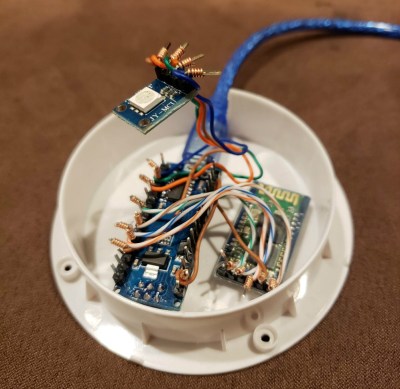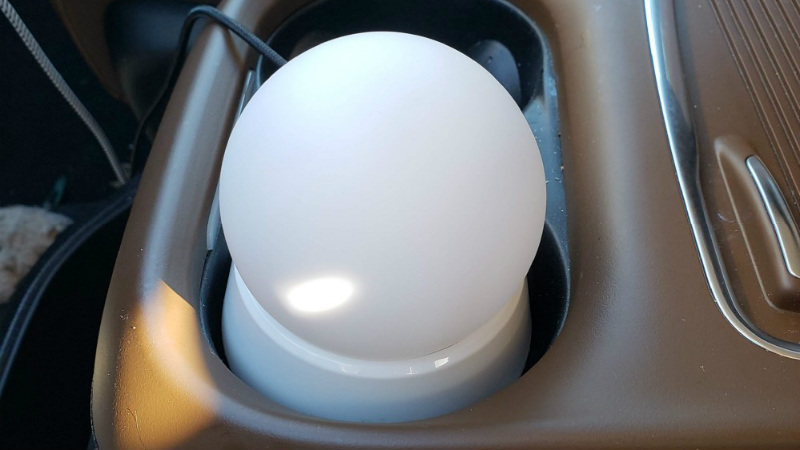Hybrid vehicles, which combine an eco-friendly electric motor with a gasoline engine for extended range, are becoming more and more common. They’re a transitional technology that delivers most of the advantages of pure electric vehicles, but without the “scary” elements of electric vehicle ownership which are still foreign to consumers such as installing a charger in their home. But one element which hybrids are still lacking is a good method for informing the driver whether they’re running on petroleum or lithium; a way to check at a glance how “green” their driving really is.
 [Ben Kolin] and his daughter [Alyssa] have come up with a clever hack that allows retrofitting existing hybrid vehicles with an extremely easy to understand indicator of real-time vehicle efficiency. No confusing graphics or arcade-style bleeps and bloops, just a color-changing orb which lives in the cup holder. An evolved version which takes the form of a smaller “dome light” that sits on the top of the dashboard could be a compelling aftermarket accessory for the hybrid market.
[Ben Kolin] and his daughter [Alyssa] have come up with a clever hack that allows retrofitting existing hybrid vehicles with an extremely easy to understand indicator of real-time vehicle efficiency. No confusing graphics or arcade-style bleeps and bloops, just a color-changing orb which lives in the cup holder. An evolved version which takes the form of a smaller “dome light” that sits on the top of the dashboard could be a compelling aftermarket accessory for the hybrid market.
The device, which they are calling the ecOrb, relies on an interesting quirk of hybrid vehicles. The OBD II interface, which is used for diagnostics on modern vehicles, apparently only shows the RPM for the gasoline engine in a hybrid. So if the car is in motion but the OBD port is reporting 0 RPM, the vehicle must be running under electric power.
With a Bluetooth OBD adapter plugged into the car, all [Ben] and [Alyssa] needed was an Arduino Nano clone with a HC-05 module to read the current propulsion mode in real-time. With some fairly simple conditional logic they’re able to control the color of an RGB LED based on what the vehicle is doing: green for driving on electric power, purple for gas power, and red for when the gas engine is at idle (the worst case scenario for a hybrid).
Check out our previous coverage of OBD hacking on the Cadillac ELR hybrid if you’re looking to learn more about what’s possible with this rapidly developing class of vehicle
















That wire wrapping!
Seriously! Always nice to see, but considering they had to solder down those headers anyway I don’t get why they didn’t just solder the wires. I guess it’s re-workable, but not much more than soldered connections. Still cool! If I had a wire wrapping tool I’d be looking for an excuse to use it as well.
I know me, I’d get the board and get straight to soldering the header pins on so I could play with it. Then finally have a project and realize I don’t have any female connectors around to put it to use in a project off a breadboard.
Hey, Ben here (part of the father/daughter build duo for this project). As it happens I had bought a box of breadboard-ready Arduino clones so there was literally nothing to solder. As you can see we went with thicker wire than the 30 gauge Kynar people use for wrapping these days so we did a little pin bending to make sure there was enough room, but we never did fire up the iron. This is the first non-soldering electronics project I have done in… I can’t even come up with a previous example.
Looks like 24 ga. unplated wire too, not the modern namby-pamby 30ga highfalutin’ silver-plated stuff. Hardcore old-skool telephone stuff. I’m not even sure where you’d get a tool for that now.
“They’re a transitional technology that delivers most of the advantages of pure electric vehicles, but without the “scary” elements of electric vehicle ownership which are still foreign to consumers such as installing a charger in their home.”
Scary? Like installing a major appliance, scary? Hybrids are about overcoming range, or duration issues.
And also people like myself that couldn’t install a charger because I don’t own the place either. It’d require a significant rewiring of the building to give residents in the building chargers for electric vehicles that are tied to their electric box.
Which is why landlords will be getting charging services installing a few stations on their property.
The model seen already is to keep charging the client the charging fee until they remove their vehicle from the station. That way people will remove their vehicle once it’s fully charged, so others get their turn at getting charged.
My 2011 Honda Insight had this integrated into the speedometer. Green = efficient, red = bad driver, bad!
My wife’s Subaru has a +/- gauge for fuel efficiency.
In the old days (git off’n my lawn whippersnapper!) we used a vacuum gauge attached to intake manifold.
In the early 80s I drove an Audi with a vacuum “economy” gauge. It got it exactly wrong. It indicated “good” driving with high vacuum, presumably because some dolt assumed low vacuum = open throttle = bad fuel consumption. It encouraged late shifting, stingy throttle and high engine RPM, all evil for gasoline engine fuel economy.
I used it by optimizing for low vacuum (“bad economy”), making it say I was an awful, immoral, leadfoot driver — but by shifting early, keep RPMs low, which reduces throttling losses and windage. On the Audi it made some difference, but (being young and reckless) I didn’t really care to measure it. On my current Subaru, my driving habits save about 25% over my partner’s.
Maybe Audi figured its drivers wanted to feel “sports car performance”, and “good” encouraged that?
B^)
And, btw: the new Subaru gauge is actually an honest-to-gosh meter driven by (of course) the computer, not a vacuum gauge: it actually does follow real fuel consumption, though without numbers — the numeric display will show that.
I’ve kept track, on a spreadsheet, of the gallons of gas put into her Subaru and the mileage at each fill-up.
Through that, I’ve found the MPG reading on the dash to be “a bit optimistic”.
The speedometer, as compared to GPS is also “a bit optimistic” as well.
My driving habits also give better MPG readings than hers. (Not 25% though)
I try to follow the 1970’s mantra “imagine an egg between your foot and the gas and brake pedals, and try not to break the egg while driving”.
I heard a few years ago that accelerating quickly to cruising speed (with an automatic transmission) was more economical…
I don’t understand why that would be true.
“imagine an egg between your foot and the gas …” Is a reasonable “one size fits all” strategy for an automatic transmission: a modern automatic will shift early and keep the engine rpm low in this case. It’s not so smart with a manual.
With a manual transmission, the mantra is “full throttle or nothing”, with the important proviso that the engine rpm is as low as possible. The main efficiency losses in a gasoline-powered engine are throttling loss (where the engine has to work to make vacuum to pull in air through a partly-closed throttle), and windage (work just to make the engine go ’round and ’round). At low RPM, the throttle is open more for a given amount of engine output power, so throttling losses are lower, and the windage (friction) losses are lower too. Keep that throttle on the floor to keep throttling losses down, and shift early to keep the engine rpm and output power low, but efficiency high.
Shifting is like voting: do it early and often.
“accelerating quickly to cruising speed (with an automatic transmission) was more economical…”
There is some truth in this, but it is a contrived example.
In the case where you want to go from point A to point B in a certain amount of time, you get there more efficiently by accelerating as quickly as possible to cruising speed, so to keep cruising speed (and air drag) low.
By accelerating very slowly, you have to make up the time by going at a faster peak speed. Since fuel consumption is about proportional to the square of the speed, you burn more fuel at that higher peak speed than you save by taking your time to get up to that speed. (You also throw away more kinetic energy braking at the end).
Again, it’s a contrived example: it assumes the constraint of a fixed travel time, and is not true if you allow the extra time to accelerate (and decelerate) slowly.
My SO has a 2014 civic. Even though it’s totally petroleum-powered, it has a color gauge in the dashboard which goes from blue to green depending on how conservatively you drive. It’s a nice feature. Reminds you when you subconsciously let your lead foot drop. I’m glad more cars, even non-hybrids, are adopting them. It would even be useful on an all-electric.
Just cut a hole in the muffler and you can easily tell when the gas engine is running.
If you are looking for a white orb to use, look no further than a dead LED light bulb.
I love father daughter projects. Done plenty of them myself.
Now they have basic concept working and neatly packaged some refinements could be smooth transitions between the modes and adding an ambient light sensor to allow altering the brightness of the Orb for day and night use . ( might even be a obd function that returns ambient light ( I’m guessing there would be something for radio illumination)
Wire wrapping is not something you generally see every day.
I had an 86′ Ford -T-bird that had a duel economy gauge. All digital gauge cluster. It did end up fairly accurate as I recall when I filled up the tank, but other than that, I didn’t mess with it much. It was an automatic transmission boat with an anemic v-8 and all the luxury options on board. It was never going to be all that fuel efficient. (18mpg on a good day)
Side story, that digital gauge cluster could flip back and forth between U.S. Imperial, and Metric units. My gauges got stuck on metric, hence a very useful and compelling lesson in learning to switch back and forth between units in my head.
The car had been abandoned on a college campus for about 8 months, and I managed to pick it up with an abandoned vehicle title. It had a bad transmission and a little water damage. But I got everything turning again for ~$600. Except the gauges. Which honestly, I think was a bad switch, but it amused me, so I never tried to fix it. Eventually sold it for $1200, and sadly, was used in fatal hit and run accident I learned about not 3 months later.
Our 2015 hybrid Camry has a bright green “EV” light in the centre of the dash when its running on electric. What does it do when you coast down a steep hill in engine braking mode?